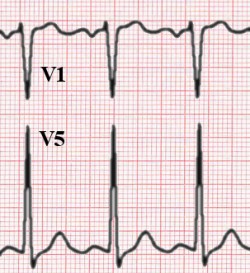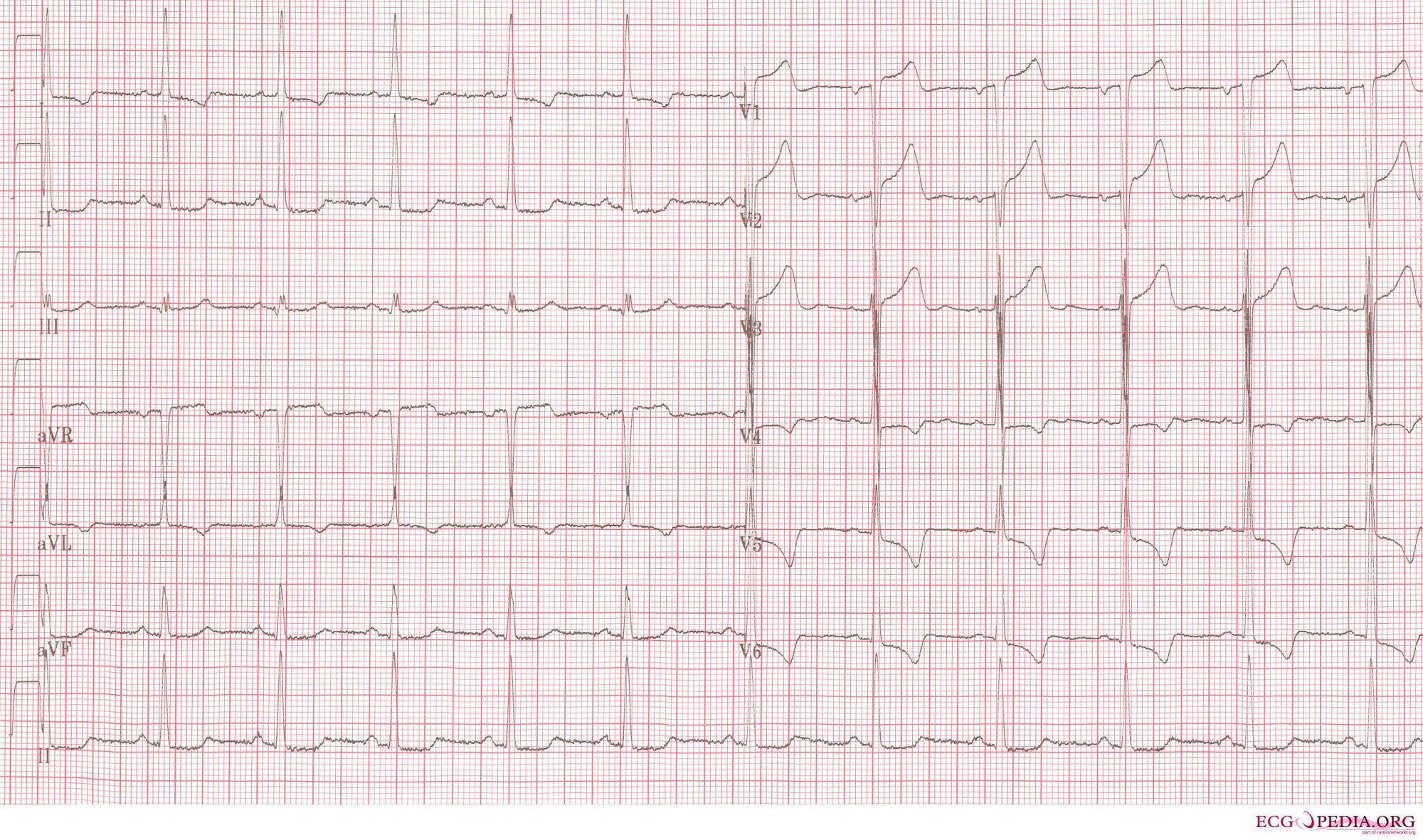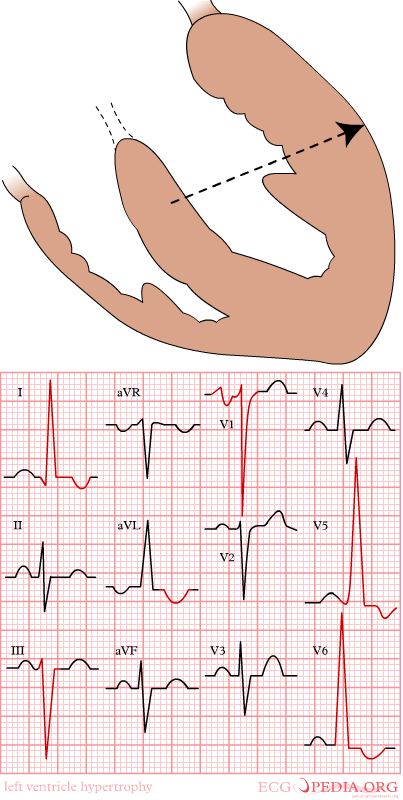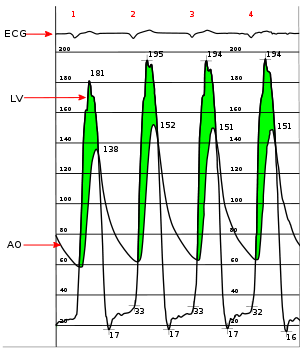Aortic stenosis electrocardiogram: Difference between revisions
m (Robot: Changing Category:Disease state to Category:Disease) |
No edit summary |
||
| Line 1: | Line 1: | ||
{{Aortic stenosis}} | {{Aortic stenosis}} | ||
{{CMG}}; '''Associate | |||
{{CMG}}; '''Associate Editor(s)-In-Chief:''' [[User:Mohammed Sbeih|Mohammed A. Sbeih, M.D.]] [mailto:msbeih@perfuse.org]; {{LG}}; '''Assistant Editor-In-Chief:''' [[Kristin Feeney|Kristin Feeney, B.S.]] [mailto:kfeeney@perfuse.org] | |||
==Overview== | ==Overview== | ||
Electrocardiogram may be used as a diagnostic tool in the evaluation of aortic stenosis | Electrocardiogram may be used as a diagnostic tool in the evaluation of aortic stenosis and reveals [[left ventricular hypertrophy]] and [[heart block]]. | ||
==Electrocardiogram== | ==Electrocardiogram== | ||
Although | *Although there are no ''specific'' findings on the [[EKG]], presence of [[left ventricular hypertrophy]] ([[LVH]]) secondary to chronic pressure overload on the [[left ventricle]] due to [[aortic stenosis]] is commonly observed. | ||
[[ | |||
*Many studies have demonstrated the prognostic consequences of presence or absence of [[Left ventricular hypertrophy]]<ref name="pmid11352882">{{cite journal| author=Sundström J, Lind L, Arnlöv J, Zethelius B, Andrén B, Lithell HO| title=Echocardiographic and electrocardiographic diagnoses of left ventricular hypertrophy predict mortality independently of each other in a population of elderly men. | journal=Circulation | year= 2001 | volume= 103 | issue= 19 | pages= 2346-51 | pmid=11352882 | doi= | pmc= | url= }} </ref><ref name="pmid7923663">{{cite journal| author=Levy D, Salomon M, D'Agostino RB, Belanger AJ, Kannel WB| title=Prognostic implications of baseline electrocardiographic features and their serial changes in subjects with left ventricular hypertrophy. | journal=Circulation | year= 1994 | volume= 90 | issue= 4 | pages= 1786-93 | pmid=7923663 | doi= | pmc= | url= }} </ref>. | |||
*Progressive [[calcific aortic valve disease|calcification of the aortic valve]] may extend beyond the valve and result in conduction abnormalities of the heart including [[heart block]] which may be apparent only on the [[EKG]] and remain undetectable otherwise. | |||
*Progressive concentric hypertrophy of the left ventricular wall may lead to larger '''QRS complexes''', especially observed in leads V1-V6. The '''S wave''' in V1 is deep, the '''R wave''' in V4 is high. Often some [[ST depression]] can be seen in leads V5-V6, which is in this setting is called a '''''strain pattern'''''. | |||
==EKG Criteria for LVH== | |||
*To diagnose [[left ventricular hypertrophy]] on the EKG one of the following criteria should be met: | |||
:*'''Sokolow-Lyon criteria:''' | |||
::*R in V5 or V6 + S in V1 >35 mm. | |||
:*'''Other criteria:''' | |||
::*R >26 mm in V5 or V6. | |||
::*R >20 mm in I, II or III. | |||
::*R >12 mm in aVL (in the absence of left anterior fascicular block). | |||
:*'''Cornell-criteria''' has different values in men and women: | |||
::* R in aVL and S in V3 >28 mm in men | |||
::* R in aVL and S in V3 >20 mm in women | |||
*In the '''Romhilt-Estes Score''',<ref name="pmid4240354">{{cite journal| author=Romhilt DW, Bove KE, Norris RJ, Conyers E, Conradi S, Rowlands DT et al.| title=A critical appraisal of the electrocardiographic criteria for the diagnosis of left ventricular hypertrophy. | journal=Circulation | year= 1969 | volume= 40 | issue= 2 | pages= 185-95 | pmid=4240354 | doi= | pmc= | url= }} </ref> | |||
:*[[LVH]] is ''likely'' with 4 or more points and | |||
:*[[LVH]] is ''present'' with 5 or more points <ref name="pmid4231231">{{cite journal| author=Romhilt DW, Estes EH| title=A point-score system for the ECG diagnosis of left ventricular hypertrophy. | journal=Am Heart J | year= 1968 | volume= 75 | issue= 6 | pages= 752-8 | pmid=4231231 | doi= | pmc= | url= }} </ref>. | |||
==Examples of EKG Findings in patients with AS== | |||
=====Left Ventricular Hypertrophy===== | |||
[[Image:LVH-ECG.jpg|left|300px|LVH-ECG]] | |||
<br clear="left"/> | |||
=====Severe LVH in a patient with Severe Aortic Stenosis===== | |||
[[Image:Extreme_lvh2.jpg|left|300px|Example of severe [[left ventricular hypertrophy]] in a patient with severe aortic valve stenosis.]] | |||
<br clear="left"/> | |||
=====Patient with LVH and Subendocardial Ischemia===== | |||
[[Image:extreme_lvh.jpg|left|300px|EKG of a patient with LVH and subendocardial ischemia leading to positive cardiovascular markers in blood testing.]] | |||
<br clear="left"/> | |||
=====LVH & Left Ventricular Strain Pattern===== | |||
[[Image:LVH.png|left|300px|[[Left ventricular hypertrophy]]; left ventricular strain due to aortic stenosis.]] | |||
<br clear="left"/> | |||
==Aortic Stenosis Hemodynamic Pressure Tracing== | |||
[[Image:Aortic Stenosis Hemodynamic Pressure Tracing.svg.png|left|300px|Aortic Stenosis Hemodynamic Pressure Tracing.]] | |||
<br clear="left"/> | |||
==References== | ==References== | ||
{{reflist|2}} | {{reflist|2}} | ||
{{WH}} | {{WH}} | ||
{{WS}} | {{WS}} | ||
[[Category:Disease]] | [[Category:Disease]] | ||
[[Category:Cardiology]] | |||
[[Category:Valvular heart disease]] | [[Category:Valvular heart disease]] | ||
[[Category:Congenital heart disease]] | [[Category:Congenital heart disease]] | ||
[[Category:Cardiac surgery]] | [[Category:Cardiac surgery]] | ||
[[Category:Surgery]] | [[Category:Surgery]] | ||
[[Category:Overview complete]] | [[Category:Overview complete]] | ||
[[Category:Template complete]] | [[Category:Template complete]] | ||
Revision as of 20:09, 11 April 2012
|
Aortic Stenosis Microchapters |
|
Diagnosis |
|---|
|
Treatment |
|
Percutaneous Aortic Balloon Valvotomy (PABV) or Aortic Valvuloplasty |
|
Transcatheter Aortic Valve Replacement (TAVR) |
|
Case Studies |
|
Aortic stenosis electrocardiogram On the Web |
|
American Roentgen Ray Society Images of Aortic stenosis electrocardiogram |
|
Directions to Hospitals Treating Aortic stenosis electrocardiogram |
|
Risk calculators and risk factors for Aortic stenosis electrocardiogram |
Editor-In-Chief: C. Michael Gibson, M.S., M.D. [1]; Associate Editor(s)-In-Chief: Mohammed A. Sbeih, M.D. [2]; Lakshmi Gopalakrishnan, M.B.B.S. [3]; Assistant Editor-In-Chief: Kristin Feeney, B.S. [4]
Overview
Electrocardiogram may be used as a diagnostic tool in the evaluation of aortic stenosis and reveals left ventricular hypertrophy and heart block.
Electrocardiogram
- Although there are no specific findings on the EKG, presence of left ventricular hypertrophy (LVH) secondary to chronic pressure overload on the left ventricle due to aortic stenosis is commonly observed.
- Many studies have demonstrated the prognostic consequences of presence or absence of Left ventricular hypertrophy[1][2].
- Progressive calcification of the aortic valve may extend beyond the valve and result in conduction abnormalities of the heart including heart block which may be apparent only on the EKG and remain undetectable otherwise.
- Progressive concentric hypertrophy of the left ventricular wall may lead to larger QRS complexes, especially observed in leads V1-V6. The S wave in V1 is deep, the R wave in V4 is high. Often some ST depression can be seen in leads V5-V6, which is in this setting is called a strain pattern.
EKG Criteria for LVH
- To diagnose left ventricular hypertrophy on the EKG one of the following criteria should be met:
- Sokolow-Lyon criteria:
- R in V5 or V6 + S in V1 >35 mm.
- Other criteria:
- R >26 mm in V5 or V6.
- R >20 mm in I, II or III.
- R >12 mm in aVL (in the absence of left anterior fascicular block).
- Cornell-criteria has different values in men and women:
- R in aVL and S in V3 >28 mm in men
- R in aVL and S in V3 >20 mm in women
- In the Romhilt-Estes Score,[3]
Examples of EKG Findings in patients with AS
Left Ventricular Hypertrophy

Severe LVH in a patient with Severe Aortic Stenosis
Patient with LVH and Subendocardial Ischemia

LVH & Left Ventricular Strain Pattern

Aortic Stenosis Hemodynamic Pressure Tracing

References
- ↑ Sundström J, Lind L, Arnlöv J, Zethelius B, Andrén B, Lithell HO (2001). "Echocardiographic and electrocardiographic diagnoses of left ventricular hypertrophy predict mortality independently of each other in a population of elderly men". Circulation. 103 (19): 2346–51. PMID 11352882.
- ↑ Levy D, Salomon M, D'Agostino RB, Belanger AJ, Kannel WB (1994). "Prognostic implications of baseline electrocardiographic features and their serial changes in subjects with left ventricular hypertrophy". Circulation. 90 (4): 1786–93. PMID 7923663.
- ↑ Romhilt DW, Bove KE, Norris RJ, Conyers E, Conradi S, Rowlands DT; et al. (1969). "A critical appraisal of the electrocardiographic criteria for the diagnosis of left ventricular hypertrophy". Circulation. 40 (2): 185–95. PMID 4240354.
- ↑ Romhilt DW, Estes EH (1968). "A point-score system for the ECG diagnosis of left ventricular hypertrophy". Am Heart J. 75 (6): 752–8. PMID 4231231.